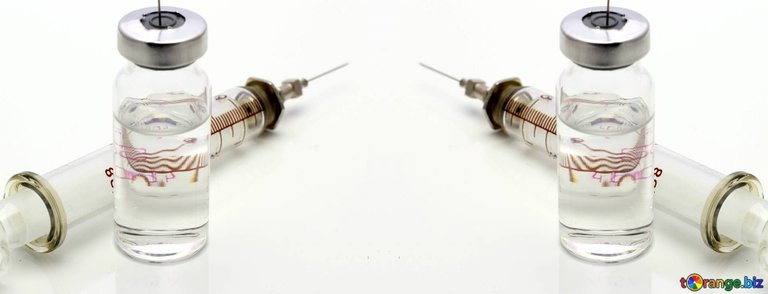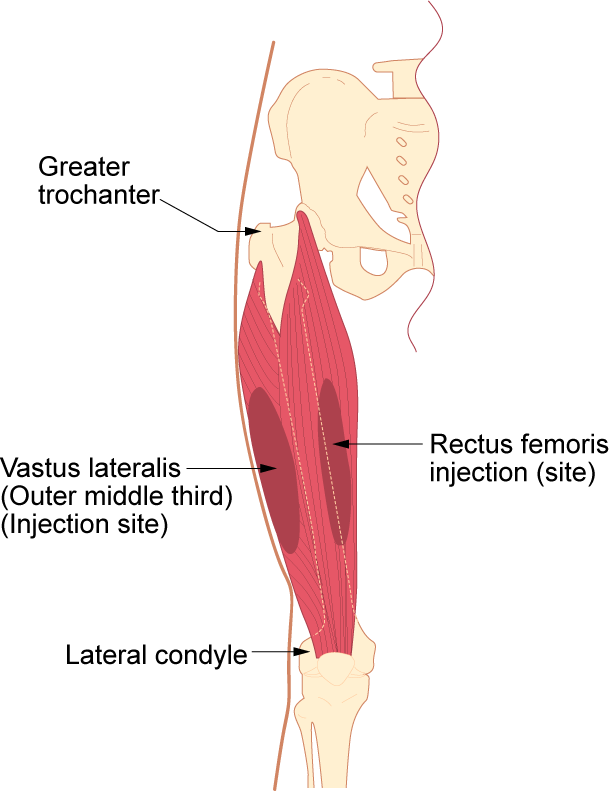I was away for a while due to my busy schedule with college and internship but now I'm back!
In nursing pills I would like to bring new things that I have learned that might be useful to someone.
Today we are going to talk about injections and in particular intramuscular injections.
As usual it is always best to seek professional help in these situations, however it is not always possible so here are some tips and general guidelines.
As the name suggests with intramuscular injections you want to inject the drug into the muscle tissue to have a fairly rapid absorption due to the fact that the muscles are irrigated by many blood vessels.
This administration is implemented in the following cases:
- specific drugs (vaccines, hormone formulations, depot formulations, some antipsychotics and some antibiotics)
- when it is not possible to use other ways of administration
- when rapid treatment is required.
Injection sites
The different sites of administration are identified through the anatomical points but before going into detail, it should be specified that:
- the smaller the muscle, the faster the absorption will be
- not all sites are suitable for self-administration for a matter of comfort and convenience
- during intramuscular administration it is necessary to be careful not to hit nerves because they could cause prolonged pain and blood vessels because they would create important hematomas and above all the drug would be injected directly into the vein and not into the muscle tissue.
The possible sites of administration are
- ventrogluteal (the site recommended by the guidelines) which is the point between the index and middle finger in the picture below

- dorsogluteal (once the most used but now no longer due to the presence of the sciatic nerve)
- deltoid (used for vaccines because very practical and fast)
- rectus femoris (used for self-administration)
- vastus lateralis (used for self-administration)
Tools
Syringe: 5 ml
Adults with well-developed muscles can tolerate an average of 3 mL of medication in a large muscle without particular muscle pain. In any case you should never go over 4-5ml which is the maximum injectable dose.Needle: 22 to 25 Gauge
Gauge is the unit of measure used for the width of the needle and is inversely proportional: a 25G needle will be thinner than a 22G one.
it is important to take the medication with a needle and then change it and use a new one for the injection.Disinfectant
Gauze also to open the vials (be careful to check that no pieces of glass have ended up in the liquid)
Drugs
Procedure
Wash hands
Identify the area to be pricked
Disinfect
Traction the skin to perform what is called a "z technique". Once you remove the needle and release the skin it creates a z-shape that blocks the reflux of the drug into the upper tissues.
Insert the needle firmly at a 90° angle.
If a site other than the ventrogluteal area is chosen, it is appropriate to perform the lesser maneuver to ensure that the needle has not been inserted into a blood vessel. Once the needle is inserted, gently aspirate for a few seconds: if blood is refusing into the syringe then remove it and choose another injection site, otherwise you can proceed.
Slowly inject the drug
Quickly remove the needle and release the skin
Apply gentle pressure with gauze, do not massage
Thank you for reading my article! I hope you enjoyed it! 🌈 😊
On the next post I would like to talk about subcutaneous injections that are a very common way of self-administration, see you next time!!
Source Nurse24
Source healthy thewom
Source infermieriitalia
Reference book

~Italian version~
Sono mancata per un po' di tempo a causa dei mille impegni con l'università e il tirocinio ma ora sono tornata.
In nursing pills vorrei portare nuove tecniche o informazioni che ho appreso e che potrebbero essere utili a qualcuno.
Oggi parleremo delle iniezioni ed in particolare le iniezioni intramuscolo.
Come al solito è sempre meglio rivolgersi ad un professionista in queste situazioni, tuttavia non è sempre possibile quindi ecco alcuni consigli e le linee guida generali.
Come suggerisce il nome con le intramuscolo si vuole iniettare il farmaco nel tessuto muscolare per avere un assorbimento abbastanza rapido grazie al fatto che i muscoli sono irrorati da molti vasi sanguigni.
Questa somministrazione si attua nei seguenti casi:
- alcuni farmaci specifici (vaccini, formulazioni ormonali, formulazioni depot, alcuni antipsicotici e alcuni antibiotici)
- non è possibile utilizzare altre vie di somministrazione
- è necessario un trattamento rapido.
Siti di iniezione
Le diverse sedi di somministrazione vengono individuate attraverso i punti anatomici ma prima di andare nel dettaglio c'è da specificare che:
- più piccolo è il muscolo, più rapido sarà l'assorbimento
- non tutte le sedi sono adatte per l'autosomministrazione per una questione di praticità e comodità
- durante le intramuscolo bisogna fare attenzione a non colpire nervi perché potrebbero causare dolore prolungato e vasi perché si creerebbero ematomi importanti e soprattutto si andrebbe ad iniettare il farmaco in vena e non più nel tessuto muscolare.
Le possibili sedi di somministrazione sono
- ventroglutea (la sede raccomandata dalle linee guida) che è il punto tra l'indice e il medio nell'immagine di sotto

- dorsoglutea ( un tempo la più usata ma ora non più a causa della presenza del nervo sciatico)
- deltoidea (usata per i vaccini perché molto pratica e veloce)
- retto femorale (usata per le autosomministrazioni)
- vasto laterale (usata per le autosomministrazioni)
Strumenti
- Siringa: 5 ml
Gli adulti con una muscolatura ben sviluppata possono tollerare mediamente 3 ml di farmaco in un muscolo grande senza particolare dolore muscolare. In ogni caso non si dovrebbe mai andare sopra i 4-5ml che corrispondono alla dose massima iniettabile. - Ago: da 22 a 25 Gauge
Gauge è l'unità di misura che si utilizza per la larghezza dell'ago ed è inversamente proporzionale: un ago da 25G sarà più sottile di uno da 22.
È importante prelevare il farmaco con un ago e poi cambiarlo e usarne uno nuovo per l'iniezione. - Disinfettante
- Garza per aprire le fiale (attenzione a controllare che nell'apertura non siano finiti pezzetti di vetro all'interno del liquido che dovrà essere iniettato)
- Farmaco
Procedura
- Lavare le mani
- Individuare la zona da pungere
- Disinfettare
- Trazionare la cute per performare quella che viene definita "tecnica a z". Cosi facendo una volta che si rimuoverà l'ago e si rilascerà la cute si creerà un passaggio a z che blocca il reflusso del farmaco nei tessuti superiori.
- Inserire l'ago con decisione e con un inclinazione a 90°
- Se si sceglie una sede che non sia la ventroglutea è opportuno attuare la manovra di lesser per accertarsi di non aver infilato l'ago in un vaso sanguigno. Una volta inserito l'ago aspirare delicatamente per qualche secondo: se refluisce sangue nella siringa allora si rimuove tutto e si sceglie un altro sito di iniezione, altrimenti si può procedere.
- Iniettare lentamente il farmaco
- Rimuovere velocemente l'ago e rilasciare la cute
- Applicare una leggera pressione con una garza, non massaggiare

Grazie per aver letto il mio articolo! Spero che vi sia piaciuto!🌈😊
Nel prossimo post vorrei parlare invece delle iniezioni sottocute che sono una delle modalità più diffusa di autosomministrazione, alla prossima!!
Source Nurse24
Source healthy thewom
Source infermieriitalia
Reference book

Congratulations @ierondale! You received a personal badge!
You can view your badges on your board and compare yourself to others in the Ranking
Check out the last post from @hivebuzz:
Support the HiveBuzz project. Vote for our proposal!